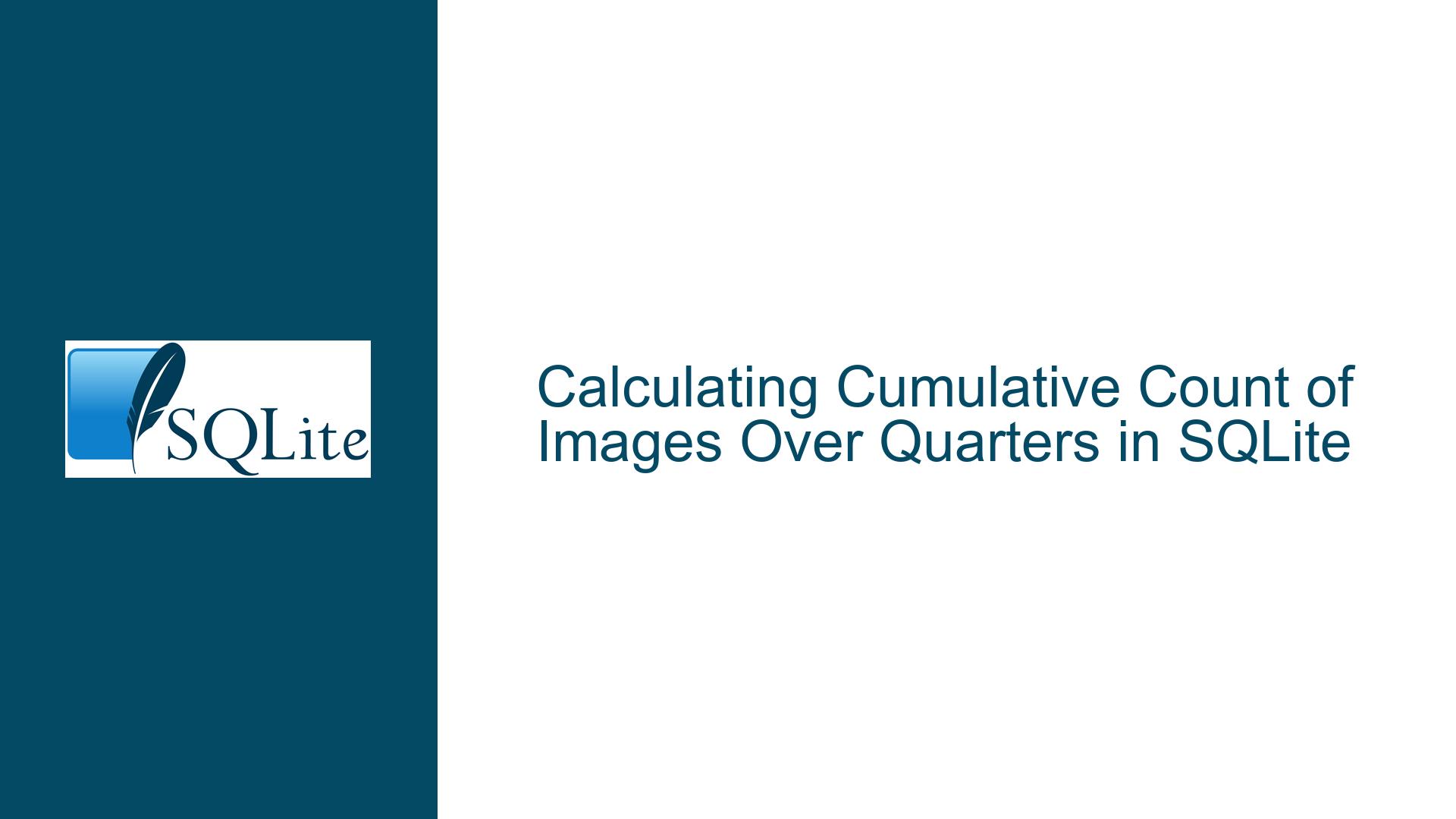Calculating Cumulative Count of Images Over Quarters in SQLite
Understanding the Cumulative Count Calculation in SQLite
The core issue revolves around calculating a cumulative count of images over quarters, where the data is stored across two tables: treatments and images. The treatments table contains a unique identifier (id) and a checkinTime timestamp, while the images table contains a unique identifier (id) and a foreign key (treatments_id) that links each image to a treatment. The goal is to calculate the cumulative count of images over quarters, resetting the count at the start of each year.
The initial query provided calculates the count of images per quarter, but it does not provide the cumulative count. The desired output is a table that includes the year, quarter, number of images in that quarter (num_of_records), and the cumulative count of images up to that quarter (cum_count). The cumulative count should reset at the start of each year.
Possible Causes of Difficulty in Calculating Cumulative Count
The difficulty in calculating the cumulative count arises from the need to maintain a running total of the number of images over time, while also resetting this total at the start of each year. This requires a mechanism to track the cumulative count across multiple rows, which is not straightforward in SQLite without the use of advanced features like window functions.
One of the primary challenges is that SQLite does not natively support some of the more advanced SQL features found in other databases, such as recursive common table expressions (CTEs) or certain types of window functions. However, SQLite does support basic window functions, which can be leveraged to achieve the desired result.
Another challenge is ensuring that the cumulative count is calculated correctly across multiple years. If the cumulative count is not reset at the start of each year, the count will continue to accumulate across years, which is not the desired behavior. This requires careful partitioning of the data by year.
Troubleshooting Steps, Solutions & Fixes
To calculate the cumulative count of images over quarters, we can use SQLite’s window functions. Window functions allow us to perform calculations across a set of table rows that are somehow related to the current row. This is particularly useful for calculating running totals, averages, and other cumulative metrics.
The first step is to calculate the number of images per quarter. This can be done using a GROUP BY clause to group the data by year and quarter, and then using the COUNT function to count the number of images in each group. The strftime function is used to extract the year and quarter from the checkinTime timestamp.
SELECT
strftime('%Y', treatments."checkinTime"/1000, 'unixepoch') AS year,
(strftime('%m', treatments."checkinTime"/1000, 'unixepoch') + 2) / 3 AS quarter,
COUNT(DISTINCT images."id") AS num_of_records
FROM images
JOIN treatments ON images.treatments_id = treatments.id
GROUP BY year, quarter;
This query will produce a table with the year, quarter, and the number of images in that quarter. However, it does not provide the cumulative count.
To calculate the cumulative count, we can use a window function. The SUM function can be used as a window function to calculate a running total. The OVER clause is used to define the window over which the sum is calculated. In this case, we want to calculate the sum over all previous rows within the same year.
WITH quarterly_counts AS (
SELECT
strftime('%Y', treatments."checkinTime"/1000, 'unixepoch') AS year,
(strftime('%m', treatments."checkinTime"/1000, 'unixepoch') + 2) / 3 AS quarter,
COUNT(DISTINCT images."id") AS num_of_records
FROM images
JOIN treatments ON images.treatments_id = treatments.id
GROUP BY year, quarter
)
SELECT
year,
quarter,
num_of_records,
SUM(num_of_records) OVER (PARTITION BY year ORDER BY year, quarter) AS cum_count
FROM quarterly_counts;
In this query, the WITH clause is used to create a common table expression (CTE) named quarterly_counts. This CTE calculates the number of images per quarter, just like the previous query. The main query then selects from this CTE and uses the SUM function as a window function to calculate the cumulative count. The PARTITION BY clause is used to reset the cumulative count at the start of each year, and the ORDER BY clause ensures that the cumulative count is calculated in the correct order.
If you want the cumulative count to continue across years without resetting, you can simply remove the PARTITION BY clause:
WITH quarterly_counts AS (
SELECT
strftime('%Y', treatments."checkinTime"/1000, 'unixepoch') AS year,
(strftime('%m', treatments."checkinTime"/1000, 'unixepoch') + 2) / 3 AS quarter,
COUNT(DISTINCT images."id") AS num_of_records
FROM images
JOIN treatments ON images.treatments_id = treatments.id
GROUP BY year, quarter
)
SELECT
year,
quarter,
num_of_records,
SUM(num_of_records) OVER (ORDER BY year, quarter) AS cum_count
FROM quarterly_counts;
This query will produce a cumulative count that continues to accumulate across years.
To further enhance the query, you can add a ROW_NUMBER window function to generate a sequential row number for each row in the result set. This can be useful for tracking the order of the rows, especially when dealing with large datasets.
WITH quarterly_counts AS (
SELECT
strftime('%Y', treatments."checkinTime"/1000, 'unixepoch') AS year,
(strftime('%m', treatments."checkinTime"/1000, 'unixepoch') + 2) / 3 AS quarter,
COUNT(DISTINCT images."id") AS num_of_records
FROM images
JOIN treatments ON images.treatments_id = treatments.id
GROUP BY year, quarter
)
SELECT
ROW_NUMBER() OVER (ORDER BY year, quarter) AS row_num,
year,
quarter,
num_of_records,
SUM(num_of_records) OVER (ORDER BY year, quarter) AS cum_count
FROM quarterly_counts;
This query will produce a result set with a sequential row number, year, quarter, number of images in that quarter, and the cumulative count of images up to that quarter.
In summary, calculating the cumulative count of images over quarters in SQLite requires the use of window functions, specifically the SUM function with the OVER clause. By partitioning the data by year and ordering it by year and quarter, you can calculate a running total that resets at the start of each year. If you want the cumulative count to continue across years, you can remove the PARTITION BY clause. Additionally, you can use the ROW_NUMBER window function to generate a sequential row number for each row in the result set. These techniques allow you to efficiently calculate cumulative counts in SQLite, even with large datasets.






